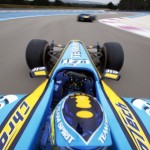Mercede’s “FRIC” system: A stroke of genius?
- This topic has 9 replies, 10 voices, and was last updated 10 years, 11 months ago by
Anonymous.
- AuthorPosts
- 10th April 2013, 16:55 at 4:55 pm #132992
mclaren
ParticipantA lot has been made about Mercedes new “FRIC” system; Ross Brawn when asked about it on sky sports kept relatively quiet, apparently Mercedes has mastered the system after 3 yrs working on it, its amazing how Brawn always has something up his sleeve with the Double DRS last year and now the FRIC system. We’re yet to see a fully dry qualifying, but the signs are there that Mercedes can challenge for pole in the dry. Could this FRIC system have put Mercs in strong title contention??
10th April 2013, 19:30 at 7:30 pm #231165Polishboy808
ParticipantNo, this isn’t what will bring them into contention. They have the third best car now (tied with Lotus I’d say), but it still isnt very close to the Ferrari or the Red Bull in qualifying. This isn’t a breakthrough system, it’s a big step up, but it isn’t as huge as the double diffuser.
That being said, this does seem to be Mercedes’ best car, and with Hamilton driving it’s got a shot at a couple of wins this season.
10th April 2013, 19:49 at 7:49 pm #231166 RagingInfernoParticipant
RagingInfernoParticipantI was under the impression that Lotus had a similar system? Either way, Mercedes don’t seem to quite have the pace to challenge for race wins just yet, though that could change if Red Bull run out of ideas for development like McLaren think they will.
10th April 2013, 21:30 at 9:30 pm #231167electrolite
ParticipantIf it gets banned, it’s an absolute fric-king joke.
10th April 2013, 22:18 at 10:18 pm #231168 Craig WoollardParticipant
Craig WoollardParticipant@electrolite I take my hat off to you.
11th April 2013, 4:45 at 4:45 am #231169raymondu999
ParticipantMeh. They’ve had their suspension tricks since 2011, as obvious from Thursday in Melbourne 2011 when the nose came off their car.
It’s just that instead of eating the tyres, the system now actually does what they want it to do.
It’s not that the system is new – it’s that the system working is new.
12th April 2013, 0:36 at 12:36 am #231170F1Yankee
ParticipantIt’s not that the system is new – it’s that the system working is new.
nice one. and just in time for lauda to can it, too.
6th May 2013, 10:20 at 10:20 am #231171 Keith CollantineKeymaster
Keith CollantineKeymasterCuriously, Minardi have put out a press release pointing out they had a similar system 20 years ago:
In this start of season the FRIC system, front and rear interactive control, applied by Mr Aldo Costa and Mr Ross Brawn to the Mercedes W04 driven by Hamilton and Rosberg, has been the one to hold the court of F1 Championship. It’s a plumbing system conceived to allow front and rear suspensions to work together, recreating the benefit of active suspensions.
It’s not a brand new system for the F1. In the ‘90s the Minardi Team had already equipped the M193 with a similar system. We’ve interviewed Mr Gabriele Tredozi, the former engineer of Minardi Team, to better understand how that system works and what its effects are. Mr Tredozi is the “father” of many cars used by the Minardi Team to take part in the F1 Championship. He started to work for the Minardi Team in 1988 as Adrian Campos’ car engineer, then he became Pier Luigi Martini’s car engineer in 1997 and, after Mr Aldo Costa moved to Ferrari, he became chief engineer of the M198 and technical coordinator of the team.
“It’s necessary to make an introductory remark first, going back to ‘90s. At the end of 1992, a new technology was enjoying a big success: active suspensions. That kind of technology could take an electronic control of the suspension through different parameters like ground elevation, rolling and pitching. All that wasn’t done through a spring system any more, but through a plumbing system”, says the engineer from Brisighella “the system consisted of actuators placed on struts. The spring-damper system received under pressure actuators’ oil by a pump and, the ground elevation of rear and front tyres, pitching and rolling were all managed by electronic controls, having a successful outcome in terms of aerodynamics. This project could be divided into two sections: an inactive one related to plumbing suspensions and an active one related to electronic controls,” says Mr Tredozi.
“The M193 driven by Martini and Fittipaldi was equipped with an inactive plumbing system: there wasn’t an external pump which placed under pressure the ground elevation. Ground elevation was equipped with traditional suspensions placed under pressure by a plumbing system. Ground elevation worked on springs ruled by water ducts and a strut placed the circuit under pressure. This was a first step before fully developing the system the following year. Unfortunately the FIA banned the system, so we had a very developed suspension which couldn’t be used. Anyway, we continued to use it even in 1994 but it never turned to be active.”
How the system worked. “The aim was to minimize rear and front elevation changes during the braking and acceleration processes. To handle car pitching in an inactive way, we linked the front shaft with the rear one – LINK-, so that, whenever the car braked pushing the nose down, the actuator created vacuum in the rear part. The vacuum was filled with the rear actuator’s oil so that even the rear part was pushed down. In this way, the car was well balanced. Since it was a crossed link, the system helped the driver even when he had to take a bend: when the external rear tyre had to bear the maximum load, the system acted on the internal front tyre, limiting car’s rolling. During the acceleration process the system worked in the opposite way: the main load was concentrated in the rear part of the car and the front part was lifted up. Actuators’ pressure let car’s nose to be pushed down to the ground. Doing that, the understeering process was slowing down.”
“In the end of 1993, the link system was banned. We continued to use plumbing suspensions, but they weren’t linked anymore. So, most of the benefits coming from the link system were lost. Nowadays F1 cars are equipped with the LINK system, which is the same we used 20 years ago.”
What are the benefits of the system? “The benefit is to reduce ground elevation’s difference between front and rear part during the braking and acceleration processes. If the car is very stable during the braking process, it will be faster and have a higher force. As a consequence, a better use of tyres will be made. Tyres slip less and the front part is ensured more stability. It takes time to develop that kind of system, as it’s so important to determine tubes’ diameter,” ends up Mr Tredozi.
6th May 2013, 14:50 at 2:50 pm #231172GeeMac
ParticipantI’m assuming that “plumbing system” is actually referring to a hydraulic system and that this has just been lost in translation?
6th May 2013, 14:55 at 2:55 pm #231173Anonymous
Inactive - AuthorPosts
- You must be logged in to reply to this topic.



